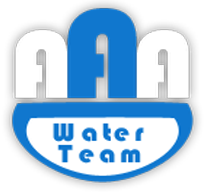Reverse osmosis is the predominate process for purifying water. In household systems it utilizes water line pressure to operate. The only downside is a drop of about a 1/3rd in the system pressure. Reverse osmosis works in conjunction with conventional filtration systems. A sediment filter removes larger particulates, important in well systems, and then passes the water through too other treatment options. Some systems include activated charcoal filters to remove odor and bad tasting chemicals. A chlorination filter handles biological contaminates. Whole house systems are available, but many reverse osmosis implementations are found under the kitchen sink, a source for drinking water.
Need to Clean & Sanitize Reverse Osmosis Systems
Reverse osmosis uses a very fine filtering media, capable of capturing molecules and bacteria. But this filtering membrane eventually becomes contaminated and requires cleaning. For particles and large bacterial organisms this is accomplished by flushing. There are two sides notable in reverse osmosis systems. The feed side, which is the source water, and the permeate chamber that holds a reservoir of filtered water.
Forward Flushing Reverse Osmosis Membrane
Forward flushing uses the feed side to clean the surface of the membrane. Water passes through the system at a relatively high speed and volume, creating turbulence that ‘scrubs’ the feed side of the membrane. Deeply imbedded particles are resistant to forward flushing and may respond better to back flushing.
Backflushing Reverse Osmosis Membrane
Back flushing use the water in the permeate side to force water back through the system under higher than normal operating pressure, breaking loose most of the imbedded particles. Note that these two systems have a lot of waste water flushed down the drain. Also the cleaning depends solely on water pressure and turbulence to break up membrane clogging containments.
Air Water Flushing RO Membrane
Enter air or air-water flush. This system uses air en-trained in the water on the feed side to clean the membrane. The air forms bubbles that create additional turbulence effective in breaking up the fouling. This system also saves water, as less water in needed in the flush cycle.
Deep Cleaning Biofilms in RO Systems
Biofilm is the slime formed by living organisms in the presence of water. The biofilms protect pathogens from any biocides that kill or inhibit them in free floating water. Biofilms harbor such nasties as E. Coli, Legionella, Listeria and other pathogens. For deep cleaning, chemicals are required. Chlorine dioxide (ClO2) is the preferred biofilm cleaning agent and is considered superior to hypochlorite. ClO2 continuously dosed at low levels can prevent biofilm formation. Other chemicals such as hydrogen chloride, nitric acid and another disinfectant hydrogen peroxide can be used when added to the permeate during a back flush cleaning. With chemical cleaning the added chemicals need to ‘soak’ before the back flush operation is initiated. Cleaning the membrane can use a combination of methods as well. Trial and error needs to be applied to determine the best method.
Reverse Osmosis Installation, Replacement & Service in Naples, Cape Coral, Fort Myers & Lehigh Acres, Florida
Reverse osmosis is a very mature and widely used technology. It is used not only to clean and purify water it for domestic use but can be instituted on an industrial level to provide potable water from sea water. Large desalination plants use ganged reverse osmosis units to supply drinking water in many of the desert-sea shore communities of the Middle East. To learn more call us at AAA Water Team. We can share our knowledge and answer questions pertaining to numerous water treatment solutions.

